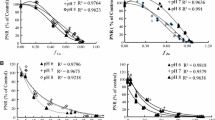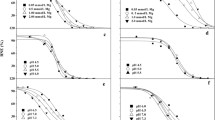Abstract
There are only a limited number of studies that have developed appropriate models which incorporate bioavailability to estimate mixture toxicity. Here, we explored the applicability of the extended biotic ligand model (BLM) and the WHAM-F tox approach for predicting and interpreting mixture toxicity, with the assumption that interactions between metal ions obey the BLM theory. Seedlings of lettuce Lactuca sativa were exposed to metal mixtures (Cu-Ni, Cu-Cd, and Ni-Cd) contained in hydroponic solutions for 4 days. Inhibition to root elongation was the endpoint used to quantify the toxic response. Assuming that metal ions compete with each other for binding at a single biotic ligand, the extended BLM succeeded in predicting toxicity of three mixtures to lettuce, with more than 82 % of toxicity variation explained. There were no significant differences in the values of f mix50 (i.e., the overall amounts of metal ions bound to the biotic ligand inducing 50 % effect) for the three mixture combinations, showing the possibility of extrapolating these values to other binary metal combinations. The WHAM-F tox approach showed a similar level of precision in estimating mixture toxicity while requiring fewer parameters than the BLM-f mix model. External validation of the WHAM-F tox approach using literature data showed its applicability for other species and other mixtures. The WHAM-F tox model is suitable for delineating mixture effects where the extended BLM also applies. Therefore, in case of lower data availability, we recommend the lower parameterized WHAM-F tox as an effective approach to incorporate bioavailability in quantifying mixture toxicity.





Similar content being viewed by others
References
Antunes PMC, Scornaienchi ML, Roshon HD (2012) Copper toxicity to Lemna minor modelled using humic acid as a surrogate for the plant root. Chemosphere 88:389–394. doi:10.1016/j.chemosphere.2012.02.052
Backhaus T, Faust M (2012) Predictive environmental risk assessment of chemical mixtures: a conceptual framework. Environ Sci Technol 46:2564–2573. doi:10.1021/es2034125
Bliss CI (1939) The toxicity of poisons applied jointly. Ann Appl Biol 26:585–615
De Schamphelaere KAC, Janssen CR (2002) A biotic ligand model predicting acute copper toxicity for daphnia magna: the effects of calcium, magnesium, sodium, potassium, and pH. Environ Sci Technol 36:48–54. doi:10.1021/es000253s
Di Toro DM, Allen HE, Bergman HL, Meyer JS, Paquin PR, Santore RC (2001) Biotic ligand model of the acute toxicity of metals. 1. Technical Basis. Environ Toxicol Chem 20:2383–2396. doi:10.1002/etc.5620201034
Erickson RJ (2013) The biotic ligand model approach for addressing effects of exposure water chemistry on aquatic toxicity of metals: genesis and challenges. Environ Toxicol Chem 32:1212–1214. doi:10.1002/etc.2222
Fortunati P, Lombi E, Hamon RE, Nolan AL, McLaughlin MJ (2005) Effect of toxic cations on copper rhizotoxicity in wheat seedlings. Environ Toxicol Chem 24:372–378. doi:10.1897/03-069R.1
Groh KJ, Carvalho RN, Chipman JK, Denslow ND, Halder M, Murphy CA, Roelofs D, Rolaki A, Schirmer K, Watanabe KH (2015) Development and application of the adverse outcome pathway framework for understanding and predicting chronic toxicity: II. A focus on growth impairment in fish. Chemosphere 120:778–792. doi:10.1016/j.chemosphere.2014.10.006
Haanstra L, Doelman P, Oude Voshaar JH (1985) The use of sigmoidal dose response curves in soil ecotoxicological research. Plant Soil 84:293–297. doi:10.1007/BF02143194
Hatano A, Shoji R (2008) Toxicity of copper and cadmium in combinations to duckweed analyzed by the biotic ligand model. Environ Toxicol 23:372–378. doi:10.1002/tox.20348
Iwasaki Y, Cadmus P, Clements WH (2013) Comparison of different predictors of exposure for modeling impacts of metal mixtures on macroinvertebrates in stream microcosms. Aquat Toxicol 132–133:151–156. doi:10.1016/j.aquatox.2013.02.007
Jho EH, An J, Nam K (2011) Extended biotic ligand model for prediction of mixture toxicity of Cd and Pb using single metal toxicity data. Environ Toxicol Chem 30:1697–1703. doi:10.1002/etc.556
Juang KW, Lee YI, Lai HY, Chen BC (2014) Influence of magnesium on copper phytotoxicity to and accumulation and translocation in grapevines. Ecotoxicol Environ Saf 104:36–42. doi:10.1016/j.ecoenv.2014.02.008
Jurkat-Rott K, Lehmann-Horn F (2004) The patch clamp technique in ion channel research. Curr Pharm Biotechnol 5:387–395. doi:10.2174/1389201043376715
Kandegedara A, Rorabacher DB (1999) Noncomplexing tertiary amines as ‘better’ buffers covering the range of pH 3–11. Temperature dependence of their acid dissociation constants. Anal Chem 71:3140–3144. doi:10.1021/ac9902594
Kortenkamp A, Backhaus T, Faust M (2009) State of the art review of mixture toxicity. Report to the Commission of the European Union (Directorate General for the Environment). http://ec.europa.eu/environment/chemicals/effects/pdf/report_mixture_toxicity.pdf. Accessed 22 Dec 2009
Le TTY, Peijnenburg WJGM, Hendriks AJ, Vijver MG (2012) Predicting effects of cations on copper toxicity to lettuce (Lactuca sativa) by the biotic ligand model. Environ Toxicol Chem 31:355–359. doi:10.1002/etc.736
Le TTY, Vijver MG, Jan Hendriks A, Peijnenburg WJGM (2013a) Modeling toxicity of binary metal mixtures (Cu2+-Ag+, Cu2+-Zn2+) to lettuce, Lactuca sativa, with the biotic ligand model. Environ Toxicol Chem 32:137–143. doi:10.1002/etc.2039
Le TTY, Vijver MG, Kinraide TB, Peijnenburg WJGM, Hendriks AJ (2013b) Modelling metal-metal interactions and metal toxicity to lettuce Lactuca sativa following mixture exposure (Cu2+-Zn2+ and Cu2+-Ag+). Environ Pollut 176:185–192. doi:10.1016/j.envpol.2013.01.017
Li B, Zhang X, Wang X, Ma Y (2009) Refining a biotic ligand model for nickel toxicity to barley root elongation in solution culture. Ecotoxicol Environ Saf 72:1760–1766. doi:10.1016/j.ecoenv.2009.05.003
Liu Y, Vijver MG, Peijnenburg WJGM (2014a) Comparing three approaches in extending biotic ligand models to predict the toxicity of binary metal mixtures (Cu-Ni, Cu-Zn and Cu-Ag) to lettuce (Lactuca sativa L.). Chemosphere 112:282–288. doi:10.1016/j.chemosphere.2014.04.077
Liu Y, Vijver MG, Peijnenburg WJGM (2014b) Impacts of major cations (K+, Na+, Ca2+, Mg2+) and protons on toxicity predictions of nickel and cadmium to lettuce (Lactuca sativa L.) using exposure models. Ecotoxicology 23:385–395. doi:10.1007/s10646-014-1202-1
Lock K, Vaneeckhout H, Deschamphelaere K, Criel P, Janssen C (2007) Development of a biotic ligand model (BLM) predicting nickel toxicity to barley (Hordeum vulgare). Chemosphere 66:1346–1352. doi:10.1016/j.chemosphere.2006.07.008
Loewe S, Muischnek H (1926) Effect of combinations: mathematical basis of problem. Arch Exp Pathol Pharmakol 114:313–326
Lofts S, Tipping E (2011) Assessing WHAM/Model VII against field measurements of free metal ion concentrations: model performance and the role of uncertainty in parameters and inputs. Environ Chem 8:501–516. doi:10.1071/En11049
Luo XS, Li LZ, Zhou DM (2008) Effect of cations on copper toxicity to wheat root: implications for the biotic ligand model. Chemosphere 73:401–406. doi:10.1016/j.chemosphere.2008.05.031
Mourato MP, Martins LL, Campos-Andrada MP (2009) Physiological responses of Lupinus luteus to different copper concentrations. Biol Plant 53:105–111. doi:10.1007/s10535-009-0014-2
Niyogi S, Wood CM (2004) Biotic ligand model, a flexible tool for developing site-specific water quality guidelines for metals. Environ Sci Technol 38:6177–6192. doi:10.1021/es0496524
OECD (2006) Test no. 227: Terrestrial plant test: vegetative vigour test, OECD guidelines for the testing of chemicals, Section 2. OECD Publishing, Paris. doi:10.1787/9789264067295-en
Qiu H, Vijver MG, Peijnenburg WJGM (2011) Interactions of cadmium and zinc impact their toxicity to the earthworm Aporrectodea caliginosa. Environ Toxicol Chem 30:2084–2093. doi:10.1002/etc.595
Rajaganapathy V, Xavier F, Sreekumar D, Mandal PK (2011) Heavy metal contamination in soil, water and fodder and their presence in livestock and products : a review. J Environ Sci Technol 4:234–249. doi:10.3923/jest.2011.234.249
Santore RC, Ryan AC (2015) Development and application of a multi-metal multi-biotic ligand model for assessing aquatic toxicity of metal mixtures. Environ Toxicol Chem 34:777–787. doi:10.1002/etc.2869
Slaveykova VI, Wilkinson KJ (2005) Predicting the bioavailability of metals and metal complexes: critical review of the biotic ligand model. Environ Chem 2:9–24. doi:10.1071/EN04076
Steenbergen NTTM, Iaccino F, de Winkel M, Reijnders L, Peijnenburg WJGM (2005) Development of a biotic ligand model and a regression model predicting acute copper toxicity to the earthworm Aporrectodea caliginosa. Environ Sci Technol 39:5694–5702. doi:10.1021/es0501971
Stockdale A, Tipping E, Lofts S, Ormerod SJ, Clements WH, Blust R (2010) Toxicity of proton-metal mixtures in the field: linking stream macroinvertebrate species diversity to chemical speciation and bioavailability. Aquat Toxicol 100:112–119. doi:10.1016/j.aquatox.2010.07.018
Stockdale A, Tipping E, Lofts S, Fott J, Garmo ØA, Hruska J, Keller B, Löfgren S, Maberly SC, Majer V, Nierzwicki-Bauer SA, Persson G, Schartau A-K, Thackeray SJ, Valois A, Vrba J, Walseng B, Yan N (2014) Metal and proton toxicity to lake zooplankton: a chemical speciation based modelling approach. Environ Pollut 186:115–125. doi:10.1016/j.envpol.2013.11.012
Tipping E, Lofts S (2013) Metal mixture toxicity to aquatic biota in laboratory experiments: application of the WHAM-F TOX model. Aquat Toxicol 142–143:114–122. doi:10.1016/j.aquatox.2013.08.003
Tipping E, Lofts S (2015) Testing WHAM-F TOX with laboratory toxicity data for mixtures of metals (Cu, Zn, Cd, Ag, Pb). Environ Toxicol Chem 34:788–798. doi:10.1002/etc.2773
Tipping E, Vincent CD, Lawlor AJ, Lofts S (2008) Metal accumulation by stream bryophytes, related to chemical speciation. Environ Pollut 156:936–943. doi:10.1016/j.envpol.2008.05.010
Tipping E, Lofts S, Sonke JE (2011) Humic Ion-Binding Model VII: a revised parameterisation of cation-binding by humic substances. Environ Chem 8:225–235. doi:10.1071/EN11016
US-EPA (1991) Methods for aquatic toxicity identification evaluation. Phase I. Toxicity characterisation procedures, 2nd edn. United States Environmental Protection Agency, Office of Water, Washington, EPA/600/6-91/003
Versieren L, Smets E, De Schamphelaere K, Blust R, Smolders E (2014) Mixture toxicity of copper and zinc to barley at low level effects can be described by the biotic ligand model. Plant Soil 381:131–142. doi:10.1007/s11104-014-2117-6
Vijver MG, Peijnenburg WJGM, De Snoo GR (2010) Toxicological mixture models are based on inadequate assumptions. Environ Sci Technol 44:4841–4842. doi:10.1021/es1001659
Wang X, Li B, Ma Y, Hua L (2010) Development of a biotic ligand model for acute zinc toxicity to barley root elongation. Ecotoxicol Environ Saf 73:1272–1278. doi:10.1016/j.ecoenv.2010.05.016
Wang YM, Kinraide TB, Wang P, Zhou DM, Hao XZ (2013) Modelling rhizototoxicity and uptake of Zn and Co singly and in binary mixture in wheat in terms of the cell membrane surface electrical potential. Environ Sci Technol 47:2831–2838. doi:10.1021/es3022107
Acknowledgments
Hao Qiu is a beneficiary of a postdoctoral mobility grant from the Belgian Federal Science Policy Office (BELSPO) (Project No. 3E150127). The authors would like to thank Edward Tipping for supporting the data analysis. The authors are grateful to five anonymous reviewers for their valuable comments on this manuscript.
Author information
Authors and Affiliations
Corresponding author
Additional information
Responsible editor: Stuart Simpson
Electronic supplementary material
Below is the link to the electronic supplementary material.
ESM 1
(DOX 60 kb)
Rights and permissions
About this article
Cite this article
Qiu, H., Vijver, M.G., He, E. et al. Incorporating bioavailability into toxicity assessment of Cu-Ni, Cu-Cd, and Ni-Cd mixtures with the extended biotic ligand model and the WHAM-F tox approach. Environ Sci Pollut Res 22, 19213–19223 (2015). https://doi.org/10.1007/s11356-015-5130-2
Received:
Accepted:
Published:
Issue Date:
DOI: https://doi.org/10.1007/s11356-015-5130-2




